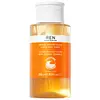REN Clean Skincare Ready Steady Glow Daily AHA Tonic Versus Laneige Water Bank Blue Hyaluronic Essence Toner
What's inside
What's inside
 Key Ingredients
Key Ingredients

 Benefits
Benefits

 Concerns
Concerns

 Ingredients Side-by-side
Ingredients Side-by-side

Water
Skin ConditioningSodium Lactate
BufferingLactic Acid
BufferingHeptyl Glucoside
Potassium Azeloyl Diglycinate
Skin ConditioningTriethyl Citrate
MaskingGlyceryl Caprylate
EmollientSalix Nigra Bark Extract
Skin ProtectingBenzoic Acid
MaskingCitrus Nobilis Peel Oil
MaskingCitrus Aurantium Dulcis Flower Oil
AstringentCitrus Grandis Peel Oil
MaskingCitrus Tangerina Peel Oil
MaskingHeptanol
PerfumingParfum
MaskingLimonene
PerfumingWater, Sodium Lactate, Lactic Acid, Heptyl Glucoside, Potassium Azeloyl Diglycinate, Triethyl Citrate, Glyceryl Caprylate, Salix Nigra Bark Extract, Benzoic Acid, Citrus Nobilis Peel Oil, Citrus Aurantium Dulcis Flower Oil, Citrus Grandis Peel Oil, Citrus Tangerina Peel Oil, Heptanol, Parfum, Limonene
Water
Skin ConditioningGlycerin
HumectantDimethicone
EmollientButylene Glycol
HumectantPentaerythrityl Tetraethylhexanoate
EmollientDipropylene Glycol
HumectantMethyl Trimethicone
Skin ConditioningGlyceryl Polymethacrylate
Phenyl Trimethicone
Skin ConditioningPCA Dimethicone
Skin ConditioningCaprylyl Methicone
Skin ConditioningHydrogenated Polyisobutene
EmollientNiacinamide
SmoothingPolysilicone-11
1,2-Hexanediol
Skin ConditioningPolysorbate 20
EmulsifyingCetearyl Alcohol
EmollientPropanediol
SolventCaffeine
Skin ConditioningGlyceryl Stearate Citrate
EmollientPolyacrylate-13
Glyceryl Stearate
EmollientC14-22 Alcohols
Emulsion StabilisingDimethiconol
EmollientAmmonium Acryloyldimethyltaurate/Vp Copolymer
Stearic Acid
CleansingMalpighia Emarginata Fruit Extract
Skin ConditioningAmmonium Acryloyldimethyltaurate/Beheneth-25 Methacrylate Crosspolymer
Emulsion StabilisingPolyisobutene
Palmitic Acid
EmollientEuterpe Oleracea Fruit Extract
Hydrogenated Lecithin
EmulsifyingCocos Nucifera Oil
MaskingGlyceryl Caprylate
EmollientArachidyl Alcohol
EmollientC12-20 Alkyl Glucoside
EmulsifyingPolyglyceryl-3 Methylglucose Distearate
EmulsifyingEthylhexylglycerin
Skin ConditioningParfum
MaskingSodium Hyaluronate
HumectantBehenyl Alcohol
EmollientArachidyl Glucoside
EmulsifyingSorbitan Isostearate
EmulsifyingDisodium EDTA
Hydrolyzed Hyaluronic Acid
HumectantBeta-Glucan
Skin ConditioningSodium Magnesium Silicate
Glucose
HumectantMyristic Acid
CleansingLauric Acid
CleansingGlutathione
Tocopherol
AntioxidantUndaria Pinnatifida Extract
Skin ConditioningWater, Glycerin, Dimethicone, Butylene Glycol, Pentaerythrityl Tetraethylhexanoate, Dipropylene Glycol, Methyl Trimethicone, Glyceryl Polymethacrylate, Phenyl Trimethicone, PCA Dimethicone, Caprylyl Methicone, Hydrogenated Polyisobutene, Niacinamide, Polysilicone-11, 1,2-Hexanediol, Polysorbate 20, Cetearyl Alcohol, Propanediol, Caffeine, Glyceryl Stearate Citrate, Polyacrylate-13, Glyceryl Stearate, C14-22 Alcohols, Dimethiconol, Ammonium Acryloyldimethyltaurate/Vp Copolymer, Stearic Acid, Malpighia Emarginata Fruit Extract, Ammonium Acryloyldimethyltaurate/Beheneth-25 Methacrylate Crosspolymer, Polyisobutene, Palmitic Acid, Euterpe Oleracea Fruit Extract, Hydrogenated Lecithin, Cocos Nucifera Oil, Glyceryl Caprylate, Arachidyl Alcohol, C12-20 Alkyl Glucoside, Polyglyceryl-3 Methylglucose Distearate, Ethylhexylglycerin, Parfum, Sodium Hyaluronate, Behenyl Alcohol, Arachidyl Glucoside, Sorbitan Isostearate, Disodium EDTA, Hydrolyzed Hyaluronic Acid, Beta-Glucan, Sodium Magnesium Silicate, Glucose, Myristic Acid, Lauric Acid, Glutathione, Tocopherol, Undaria Pinnatifida Extract
 Reviews
Reviews

Alternatives
Ingredients Explained
These ingredients are found in both products.
Ingredients higher up in an ingredient list are typically present in a larger amount.
Glyceryl Caprylate comes from glycerin and caprylic acid, a fatty acid from coconut. It has emollient and emulsifier properties.
As an emollient, it helps hydrate your skin. Emollients work by creating a barrier on your skin to trap moisture in, helping to keep your skin soft and smooth.
On the other hand, emulsifiers prevent ingredients (such as oil and water) from separating.
Learn more about Glyceryl CaprylateParfum is a catch-all term for an ingredient or more that is used to give a scent to products.
Also called "fragrance", this ingredient can be a blend of hundreds of chemicals or plant oils. This means every product with "fragrance" or "parfum" in the ingredients list is a different mixture.
For instance, Habanolide is a proprietary trade name for a specific aroma chemical. When used as a fragrance ingredient in cosmetics, most aroma chemicals fall under the broad labeling category of “FRAGRANCE” or “PARFUM” according to EU and US regulations.
The term 'parfum' or 'fragrance' is not regulated in many countries. In many cases, it is up to the brand to define this term.
For instance, many brands choose to label themselves as "fragrance-free" because they are not using synthetic fragrances. However, their products may still contain ingredients such as essential oils that are considered a fragrance by INCI standards.
One example is Calendula flower extract. Calendula is an essential oil that still imparts a scent or 'fragrance'.
Depending on the blend, the ingredients in the mixture can cause allergies and sensitivities on the skin. Some ingredients that are known EU allergens include linalool and citronellol.
Parfum can also be used to mask or cover an unpleasant scent.
The bottom line is: not all fragrances/parfum/ingredients are created equally. If you are worried about fragrances, we recommend taking a closer look at an ingredient. And of course, we always recommend speaking with a professional.
Learn more about ParfumWater. It's the most common cosmetic ingredient of all. You'll usually see it at the top of ingredient lists, meaning that it makes up the largest part of the product.
So why is it so popular? Water most often acts as a solvent - this means that it helps dissolve other ingredients into the formulation.
You'll also recognize water as that liquid we all need to stay alive. If you see this, drink a glass of water. Stay hydrated!
Learn more about Water